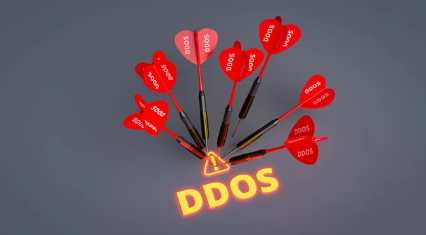
DOS and DDoS Attacks
In the digital age, the internet has become an indispensable part of our daily lives. With the rise of online transactions, social media, and e-commerce, the importance of a secure online presence cannot be overstated. However, the internet is also a breeding ground for malicious activities, and one of the most significant threats to online security is the Denial of Service (DoS) and Distributed Denial of Service (DDoS) attacks.
What is a DoS Attack?
A Denial of Service (DoS) attack is a type of cyber-attack where an attacker attempts to make a computer or network resource unavailable by flooding it with traffic from a single source. The goal of a DoS attack is to overwhelm the targeted system, making it impossible for legitimate users to access it. This can be achieved by sending a large number of packets of data to the targeted system, exceeding its capacity to handle the traffic.
Imagine a scenario where a group of people are trying to enter a concert venue, but a single individual is blocking the entrance, preventing others from entering. This is similar to a DoS attack, where a single attacker is flooding the system with traffic, making it unavailable to others.
What is a DDoS Attack?
A Distributed Denial of Service (DDoS) attack is a more sophisticated and devastating form of DoS attack. In a DDoS attack, multiple compromised computers or devices (known as “bots” or “zombies”) are used to flood the targeted system with traffic. These compromised devices are often part of a botnet, a network of infected computers that can be controlled remotely by the attacker.
DDoS attacks are like a coordinated effort by a group of individuals to block the entrance of the concert venue, making it impossible for anyone to enter. The sheer volume of traffic generated by the botnet can bring even the most robust systems to their knees.
How DoS and DDoS Attacks Happen?
DoS and DDoS attacks can occur in various ways, including:
- IP Spoofing: Attackers can spoof their IP addresses to make it appear as if the traffic is coming from a legitimate source.
- Malware: Malware can be used to compromise devices and turn them into bots, which can then be used to launch DDoS attacks.
- Vulnerabilities: Exploiting vulnerabilities in software or hardware can allow attackers to gain control of devices and use them for DDoS attacks.
- Amplification Attacks: Attackers can use third-party services, such as DNS or NTP servers, to amplify their traffic and overwhelm the targeted system.
Consequences of DoS and DDoS Attacks
The consequences of DoS and DDoS attacks can be severe, including:
- Downtime: The targeted system may become unavailable, resulting in lost productivity and revenue.
- Reputation Damage: A DDoS attack can damage a company’s reputation and erode customer trust.
- Financial Loss: DDoS attacks can result in significant financial losses, particularly for e-commerce sites or online businesses.
- Data Breaches: In some cases, DDoS attacks can be used as a distraction to launch more sinister attacks, such as data breaches.
Preventing DoS and DDoS Attacks
While it is impossible to completely eliminate the risk of DoS and DDoS attacks, there are steps that can be taken to prevent and mitigate them:
- Firewalls and Intrusion Detection Systems: Implementing firewalls and intrusion detection systems can help detect and block suspicious traffic.
- Rate Limiting: Implementing rate limiting can help prevent excessive traffic from overwhelming the system.
- Content Delivery Networks (CDNs): CDNs can help distribute traffic and reduce the load on the targeted system.
- DDoS Protection Services: Many service providers offer DDoS protection services that can help detect and mitigate attacks.
- Regular Security Audits: Regular security audits can help identify vulnerabilities and prevent exploitation.
- Employee Education: Educating employees on the risks of DoS and DDoS attacks can help prevent attacks that rely on human error.
Conclusion
DoS and DDoS attacks are a significant threat to online security, and it is essential to understand the risks and take steps to prevent and mitigate them. By implementing robust security measures, educating employees, and staying vigilant, individuals and organizations can reduce the risk of falling victim to these devastating attacks. Remember, in the digital age, security is everyone’s responsibility, and it is up to us to protect ourselves and our online presence from the menacing world of DoS and DDoS attacks.
Recent notable DDoS attacks
- February 2020: AWS Attack – A massive DDoS attack on AWS, with a record-breaking size from a botnet that was significantly smaller than those used in previous attacks.
- October 2020: Google Attack – A record-breaking UDP amplification attack sourced out of several Chinese ISPs, which remains the largest bandwidth attack of which Google is aware.
- November 2021: Microsoft Azure Attack – A DDoS attack targeting an Azure customer with a throughput of 3.45 Tbps and a packet rate of 340 million PPS, believed to be the largest DDoS attack ever recorded.
- 2023: HTTP/2 Rapid Reset Attack – A new DDoS attack method that could bypass traditional methods of DDoS protection, such as rate limiting or basic blocklists.
- 2021: European Gambling Company Attack – A DDoS attack on a European gambling company, with a threat attack weighing in at 800Gbps, notable not just for its scale but also for its novelty, using a previously unseen DDoS attack vector based on a networking protocol known as Datagram Congestion Control Protocol (DCCP).
These attacks demonstrate the increasing scale and sophistication of DDoS attacks, and the need for organizations to stay ahead of potential threats to minimize system downtime and safeguard brand reputation.
Join us on Telegram for latest cyber security news.



